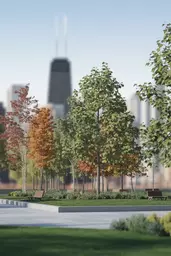Protecting Urban Trees from Pests

Posted on: 2025-11-03
By: Keira Vallejo
Urban trees are essential to our cities, yet they face numerous threats from pests and diseases. Did you know that a diverse ecosystem can significantly help in controlling these pests? This article unveils the crucial role of urban trees and the pests that threaten them, emphasizing the need for proactive measures to ensure their health.
What You Will Learn
- Urban trees enhance air quality, reduce temperatures, and provide habitats for wildlife, making their protection vital for ecosystem health.
- Common pests, such as aphids, caterpillars, and beetles, can severely impact tree health, calling for vigilant monitoring and timely interventions.
- Encouraging biodiversity in urban spaces can naturally deter pests by attracting beneficial insects that help control pest populations.
- Recognizing the signs of common pests, like spider mites and goldspotted oak borers, is essential for early intervention and maintaining tree vitality.
- Visual aids, such as pest identification charts, can greatly assist in spotting and addressing pest issues within communities.
- Regular health checks on trees can help identify diseases early, ensuring that trees remain robust and capable of withstanding pest pressure.
Common Urban Tree Pests and Their Impact
Understanding the variety of pests that threaten urban trees is crucial for effective management. Below is a summary of common pests and their effects on tree health.
Aphids
Tiny insects that suck sap from leaves, causing wilting.
Caterpillars
Larvae that can strip leaves quickly, harming tree health.
Beetles
Some species tunnel into tree bark, leading to structural damage.
Spider Mites
Can cause leaves to yellow and become speckled.
Goldspotted Oak Borer
Burrows into wood, weakening the tree.
Gloomy Scale Insect
Leads to sticky leaves and black sooty mold.
Understanding the Importance of Protecting Urban Trees from Seasonal Pests and Insects
Urban trees are not just pretty sights in our parks and streets; they play a crucial role in our city ecosystems. These trees provide shade, improve air quality, and create habitats for various wildlife. When we protect and care for our urban trees, we're not just enhancing our immediate environment; we're nurturing the entire urban ecosystem that supports us all.
However, urban trees face many challenges, particularly from seasonal pests and insects that threaten their health. Understanding these threats is important to ensure that our green allies continue to thrive. As someone who deeply cares about urban forestry, I believe that by learning about these pests, we can better protect our trees and, in turn, our communities.
The Role of Urban Trees in Ecosystems
Urban trees serve multiple functions that greatly benefit city life. They help reduce air pollution by filtering harmful contaminants, provide natural cooling through shade, and even assist in managing stormwater runoff. Each tree is like a little ecosystem, offering a home for birds, insects, and other wildlife that contribute to a balanced environment. To ensure the health of these vital components of our cities, consider benefits of professional tree care.
- Air Quality Improvement: Trees absorb carbon dioxide and release oxygen.
- Temperature Regulation: Shade from trees can lower surrounding temperatures.
- Wildlife Habitat: Trees support diverse species, promoting biodiversity.
By appreciating the multifaceted contributions of urban trees, we can better advocate for their protection. They are vital components of our cities, and their health directly impacts our quality of life.
Overview of Seasonal Pest Challenges in Urban Environments
As the seasons change, urban trees become susceptible to various pests and insects that can harm their growth and vitality. Some common seasonal pests include aphids, caterpillars, and beetles, which often emerge during spring and summer. These pests can cause damage, such as leaf loss and tree decay, which, if left unchecked, may lead to more significant issues.
- Aphids: Tiny insects that suck sap from leaves, causing wilting.
- Caterpillars: Larvae that can strip leaves quickly, harming tree health.
- Beetles: Some species tunnel into tree bark, leading to structural damage.
It's essential to monitor these pests closely to prevent them from establishing a stronghold. With timely interventions, we can ensure that our urban trees remain healthy and robust, ready to support our communities.
Impact of Urban Biodiversity on Pest Dynamics
The diversity of urban landscapes plays a significant role in controlling pest populations. A rich variety of species can help create a balanced ecosystem that naturally deters pests. For instance, certain plants attract beneficial insects that prey on common pests, effectively reducing their numbers. Understanding the connections between trees and urban wildlife can provide deeper insights into maintaining this balance.
- Plant Diversity: Incorporating a range of plant species can disrupt pest life cycles.
- Beneficial Insects: Ladybugs and lacewings are natural predators of aphids.
- Companion Planting: Some plants repel pests when grown alongside trees.
Encouraging biodiversity in our urban environments not only enhances the beauty of our neighborhoods but also helps create healthier ecosystems. As I often remind my readers at Urban Canopy Blog, a thriving urban forest is a resilient one! Let’s commit to nurturing our urban trees and the biodiversity that supports them.
Pro Tip
Did you know? Regularly inspecting your urban trees for early signs of pest infestations not only protects their health but also enhances the overall beauty of your environment. Simple actions like checking for unusual leaf discoloration or webbing can help identify problems before they escalate. Additionally, consider using organic pest control methods, such as introducing beneficial insects like ladybugs, to maintain a healthy balance in your urban ecosystem!
Comprehensive Pest Identification Guide for Urban Trees
Identifying pests is crucial for the health of our urban trees! Knowing which pests are common can help us take proactive measures before they cause any serious harm. In urban settings, trees face a variety of seasonal challenges. Let’s explore the most common pests and their impacts on our beloved greenery.
Some of these culprits can be quite sneaky, hiding among leaves or burrowing into bark. Understanding their behavior and signs of infestation is the first step in effective tree care. As someone who cares deeply about our urban landscapes, I believe that we can all benefit from recognizing these pests and their telltale signs.
Common Seasonal Pests and Their Impact
Let’s dive into the specifics of common pests that affect urban trees. Here are a few notorious ones you should watch out for:
- Spider Mites: Tiny but mighty, these pests can cause leaves to yellow and become speckled.
- Goldspotted Oak Borer: This beetle is harmful to oaks, as it burrows into the wood, weakening the tree.
- Gloomy Scale Insect: Found on various trees, this pest can lead to sticky leaves and black sooty mold.
By recognizing these pests early on, we can prevent significant damage to our trees. It’s a team effort in our urban ecosystems, and a little knowledge goes a long way!
Detailed Profiles of Notable Pests: Spider Mites, Goldspotted Oak Borer, and Gloomy Scale Insect
To effectively manage these pests, let’s take a closer look at each one:
- Spider Mites: Often thrive in hot, dry conditions. Look for fine webbing and stippled leaves.
- Goldspotted Oak Borer: Typically targets stressed oak trees. Infestations leave noticeable exit holes in the bark.
- Gloomy Scale Insect: This pest can produce a sticky residue on leaves and may lead to mold growth.
Understanding their life cycles and behaviors helps us time our interventions perfectly, ensuring the health of our urban forests.
Visual Aids for Pest Identification
Sometimes words aren’t enough, and that’s where visual aids come in handy! Pictures of pests can help you spot them faster. I recommend using guides or apps specific to urban entomology, which can provide clear images and additional details. A picture is worth a thousand words when it comes to identifying pests!
Consider creating a visual identification chart for your community. This can be a fun project that promotes awareness and education among neighbors. Together, we can spot problems before they escalate!
Identifying Tree Diseases and Their Effects on Tree Health
It's not just pests we need to worry about; tree diseases can also wreak havoc on our urban landscapes. Conditions like root rot and fungal infections often manifest in subtle ways. Signs may include wilting leaves, discoloration, or even branch dieback. For more information on maintaining healthy urban trees, explore this guide to maintaining urban tree canopies.
By being proactive and conducting regular health checks on trees, we can spot these issues early. Let's remember that a healthy tree is our best defense against pests and diseases. Together, we can cultivate the vibrant urban canopy we all desire!
Frequently Asked Questions (FAQs)
Why are urban trees important?
Urban trees improve air quality, reduce temperatures, provide wildlife habitats, and enhance the overall urban ecosystem.
What are some common pests that affect urban trees?
Common pests include aphids, caterpillars, beetles, spider mites, goldspotted oak borers, and gloomy scale insects.
How does biodiversity help in controlling pests?
A diverse urban landscape attracts beneficial insects and disrupts pest life cycles, naturally deterring pest populations.
What are some signs of pest infestation in urban trees?
Signs include wilting leaves, yellowing or speckled leaves, fine webbing, exit holes in the bark, and sticky residue on leaves.
Why is regular tree health monitoring important?
Regular checks help identify diseases and pest infestations early, allowing for timely intervention and healthier urban forests. You may also wish to check out these summer tree care tips for cities.
Recap of Key Points
Here is a quick recap of the important points discussed in the article:
- Urban Trees' Role: They improve air quality, provide shade, and offer habitats for wildlife, enhancing urban ecosystems.
- Seasonal Pest Awareness: Common pests like aphids, caterpillars, and beetles pose threats to tree health during specific seasons.
- Promoting Biodiversity: A diverse urban landscape can naturally deter pests and support beneficial insects.
- Pest Identification: Recognizing pests such as spider mites and goldspotted oak borers is crucial for effective management.
- Regular Tree Health Checks: Proactive monitoring helps catch tree diseases early, ensuring healthier urban forests.
 In urban environments, trees are often the unsung heroes contributing to our well-being and the over
In urban environments, trees are often the unsung heroes contributing to our well-being and the over
 Urban trees are essential to our cities, yet they face numerous threats from pests and diseases. Did
Urban trees are essential to our cities, yet they face numerous threats from pests and diseases. Did
 Did you know that urban tree diversity is crucial not just for aesthetics, but for the health of ent
Did you know that urban tree diversity is crucial not just for aesthetics, but for the health of ent